Wiang Kalong: Earthenware from the City of Lost Crows
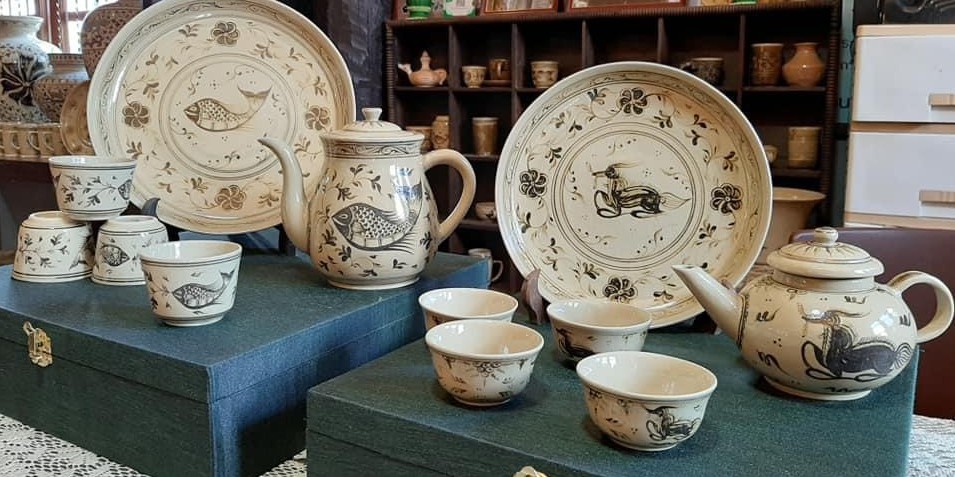
[cr. Shopee: เครื่องเคลือบดินเผาเวียงกาหลง โดย ทัน]
Ruins of kilns can be found scattered across the ancient lands of Lanna (ล้านนา), a kingdom that once spanned a large portion of present-day Northern Thailand. Out of all the earthenware variations produced from these kilns, only one reigns supreme as the pride of Lanna: the Waing Kalong earthenware.
The Wiang Kalong Site
Wiang Kalong (เวียงกาหลง) is an ancient settlement located at foothills of Doi Dong Mountain Range near Ban Pa Lan Village in Wiang Pa Pao District, Chiang Rai Province. The name “Wiang Kalong” can be interpreted as either the “City of Kalong Trees” or “City of Lost Crows”. The first interpretation is quite straightforward: the city was once surrounded by white orchid-trees, known in Thai as kalong (กาหลง). The second interpretation seems to have arisen from the city’s peculiar entrances, which are said to have been so complex that even crows became lost trying to find their way in.
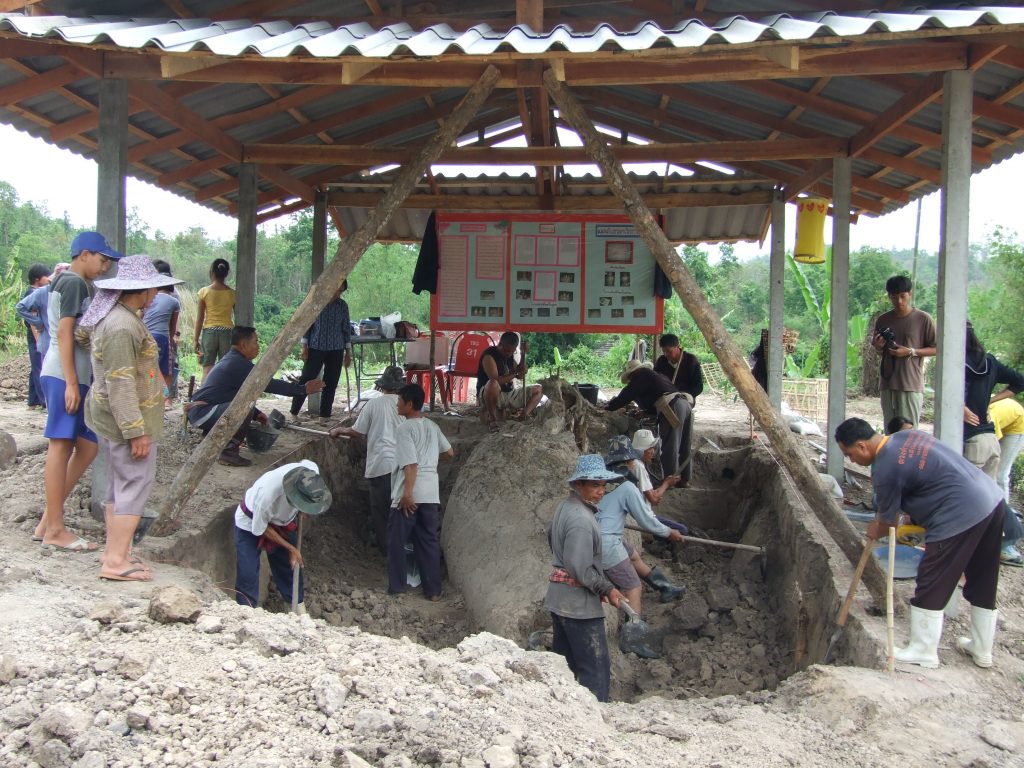
Excavations of a kiln [cr. monsterarchaeologist.wordpress.com]
In 1924, Thai historian and archaeologist Phraya Nakhon Praram (Sawat Mahakayi: 1884-1937), discovered traces of ancient kilns in an area close to the Wiang Kalong site. After Phraya Nakhon Praram’s findings were published in the Siam Society Journal in 1937, academics became intrigued by the mysterious site, leading to further researches and excavations.
An excavation by the Department of Fine Arts in 1982 revealed that several kilns were located along the creeks outside of the city’s wall. This discovery suggested that Wiang Kalong did not function as a political center, but was rather the heart of a town cluster that governed a larger community of earthenware producers.
The Kilns
Kilns connected to the Wiang Kalong culture can be found in clusters along the banks of the Lao River. More than 200 kilns have been unearthed by researchers, mostly consisting of a single-room chamber with a curved roof. There are two main types of kilns:
- Clay kilns – Kilns of this type are constructed out of bamboo frames, which are then covered in layers of clay. The kilns were constructed around 21st to 23rd centuries Buddhist Era (BE), or 16th to 17th centuries AD, and are believed to be the first type of kilns to appear at the site.
- Brick kilns – Kilns of this type began appearing approximately 100 years after the clay kilns. Brick kilns were constructed out of raw, sundried bricks, which are staked together to form the wall and roof of the furnace.
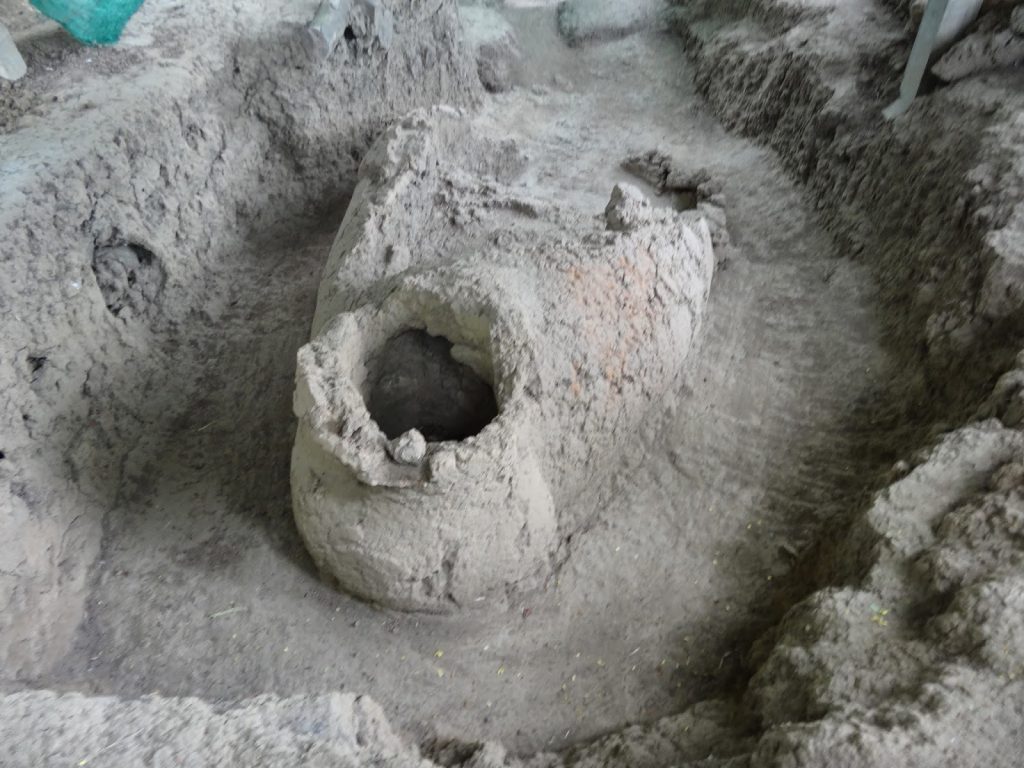
Excavated kiln [ cr. bangjong4000.blogspot.com]
Wiang Kalong kilns were mostly small, with the furnace chamber measuring around 3.5 – 4.8 meters long and 1.5 – 2 meters wide. A single kiln was divided into two sections. The first section ran from the base of the chimney to the fire-retention wall and was where all uncooked wares were placed. The other section ran from the fire-retention wall to the mouth of the chimney, and was used to place firewood. The kiln’s interior floor was covered with coarse sand. Earthenware was carted into and out of the kilns through two entrances: 1) through a hole in the ceiling connected to the stove 2) through a side wall of the kiln that was closed with bricks and reopened once firing was complete.
Wiang Kalong Earthenware
Wiang Kalong earthenware’s uniqueness comes from its light color, which is obtained from the fine-grained clays that surround the site. The clays themselves encompassed white, soft yellow, and grey hues, with a smooth texture that consisted of very few sand particles. The ceramics produced from these clays were light blue, light green, and light yellow in color, with a glaze that reached to the rim of the container. Certain types of containers had their bottoms glazed or were painted in brown at the base. Plates, bowls, vases, jars with lids, large, and small jars were the most common types of ceramics produced, although chess pieces and animal figurines were also found at the site.
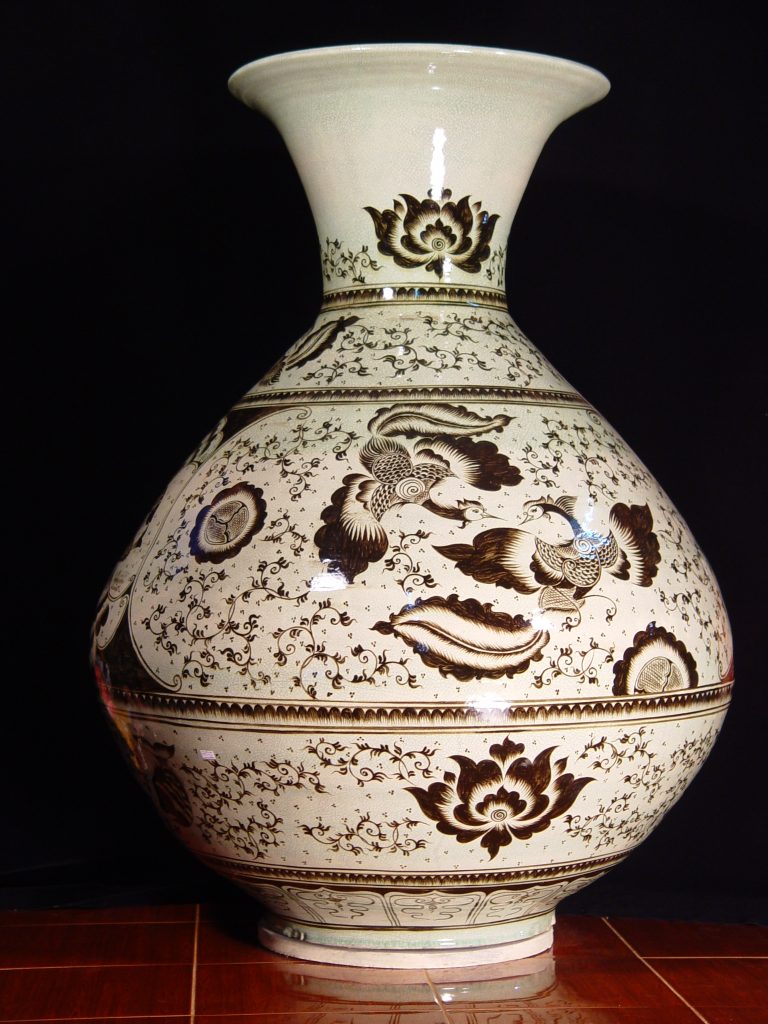
Modern Wiang Kalong earthenware [cr. Chiang Mai News]
The black crow pattern was the trademark of Waing Kalong wares. The pattern depicts a crow-like figure flying high in the sky. Other patterns found on the pottery included flower petals, trees, and fish. There were also patterns believed to be influenced by places afar, such as a Chinese and Vietnamese inspired pavilions, flowers, and dragons. Clear-glazed wares were often decorated with flower petals.
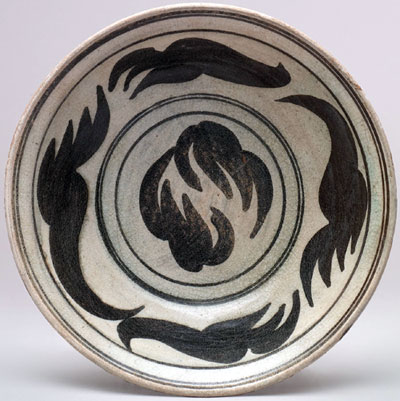
Crow pattern [cr. scene4.com: Janine Yasovant]
Ancient Wiang Kalong earthenware can be categorized into five categories, including:
- Glazed black pattern earthenware
This type of pottery was the most popular, with a timespan of production that lasted from the 19th to 22nd centuries BE (14th to 17th centuries AD). The ceramics were fired in high-temperature kilns, with patterns being drawn on both the interior and exterior surfaces. The most common color was white, though pieces of yellow-grey ceramics can also be found. The glaze covered both the interior and exterior of the ceramics.
From the late 19th to mid 20th century BE (14th-15th centuries AD), this type of earthenware became influenced by Chinese ceramics of the Yuan Dynasty (1279-1368). During this period, most production was in the form of long-necked vases and non-glazed, shallow, heavy vases with a mouth decorated with lotus and spiral-shaped patterns. Later on, from the late 20th to mid 21th century BE (15th-16th centuries AD), the earthenware was influenced by the Vietnamese Lê Dynasty (1328-1527). Dishes, bowls, jars, and small containers featured thick and high rims decorated with flower, spiral, and lotus petal patterns.
In the early to late 21st century BE (16th century AD), the earthenware was influenced by China’s Ming Dynasty (1368-1644) ceramics. During this period, production was very similar to Chinese ceramics. Most patterns found during this time were spiral-shaped or featured dragons, polka dots, triangles, and landscapes.
The final period of this type of Wiang Kalong earthenware was between mid 21st to early 22nd century BE (16th-17th century AD). This was when the uniqueness of the Wiang Kalong was most vibrantly expressed. The ceramics were ultra-thin, just around 2 – 4 millimeters in thickness. The rim was delicate, low, and non-glazed. The exterior surface was decorated mostly with lotus petal and flower patterns, with some other patterns created by the imaginations of local artists.
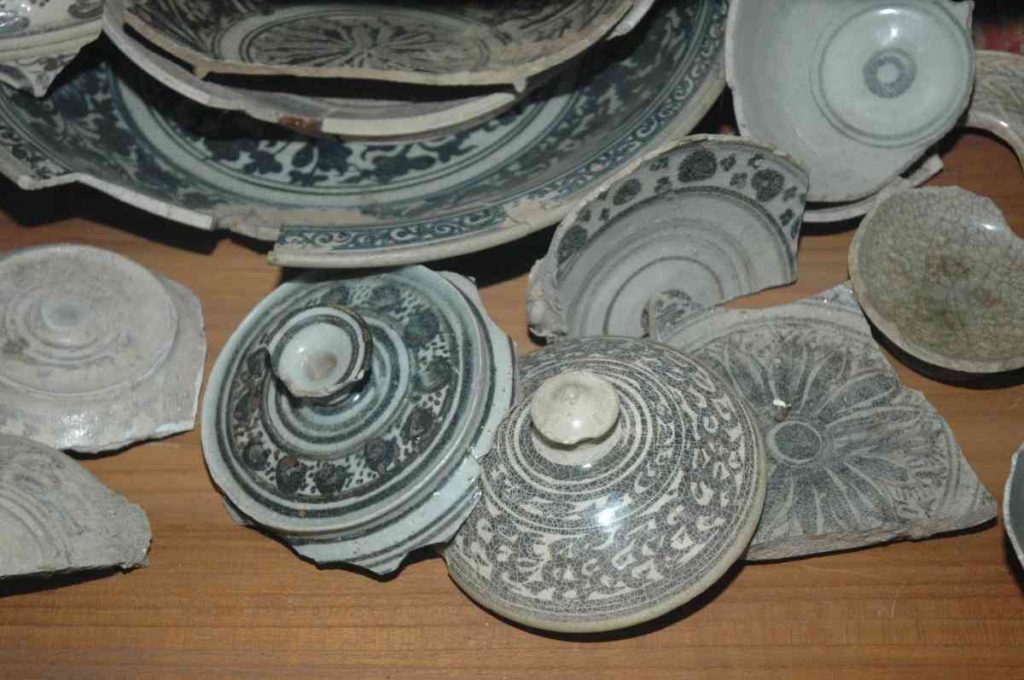 An array of ancient earthenware [cr. Chiang Mai News]
An array of ancient earthenware [cr. Chiang Mai News]
- Clear-glazed, clear-color earthenware
This type of pottery was extremely thin. The ceramics were fired at high temperatures and layered with white clay and water before being glazed. The products are recognized for their greyish tone and clear glaze, with a hint of green, light blue, or light yellow, resembling the chinaware of the Sung Dynasty (960-1279). The most common items were in the form of wide-mouthed bottles, round-mouthed jars, small jars with handles on both sides, lamps, tiny bowls, deep bowls, plates, and animal figurines.
Patterns were made with a tool that looked like a comb, with wavy designs drawn by sliding the tool up and down the clay structure. Sometimes, these wavy patterns were intricately drawn into forms of animals, flying birds, and lotus petals before being glazed. The earthenware is thought to have been made from mid 21st to early 22nd century BE (16th – 17th centuries AD).
- Green celadon glazed earthenware
This type of pottery was quite thin but thickly glazed. The colors of the glaze included dark green, light-green, and matte. The most common items produced in this style were bowls of different sizes. The big and heavy bowls, in particular, are known for their light-green glaze, which was left uneven to reveal the bright grey or white clay texture. These ceramics were made during the same period as the clear-glazed, clear-color earthenware.
- Brown-glazed earthenware
This type of pottery was produced in the same period as the clear-glazed, clear-color and green celadon glazed earthenware, but are much rarer. Items produced in this style included bottles, bowls, as well as small and large jars. Entire pieces of the wares were left bare without much decorations. The glaze was thin, mostly uneven, and reddish or blackish-brown in hues. The color of the clay used was white.
- Copper or zinc green-glazed earthenware
This type of pottery was fired in low heat and thinly glazed with a mixture containing copper and zinc. The most common items produced in this style included small jars, bottles, and Buddha images, all of which were scarcely decorate. These items were not warmly received as they were considered as being of low quality. Their age is believed to be in the same range as their brown-glazed ware counterparts.
Lanna’s Most Important Earthenware
Following the Department of Fine Arts’ explorations of the Wiang Kalong site from 1972 to 1982, the ceramic remnants became a point of interest for antique lovers. This attracted looters, which resulted in the destruction of kilns and other archeological evidences. Yet, attempts to conserve the site as a place for education and tourism also emerged during this period.
Two men are credited with helping to preserve the Wiang Kalong pottery. Sri Luemnate and Tan Thichitang (founder of the Ban Tung Man craft cluster) have succeeded in reconstructing ancient production methods and decorative techniques. Through this success, they have been able to reproduce quality recreations of the earthenware favored by collectors and the general public. The result is that the pottery items are now available as souvenirs and contemporary dishware. They have also transferred their knowledge to the younger generations.
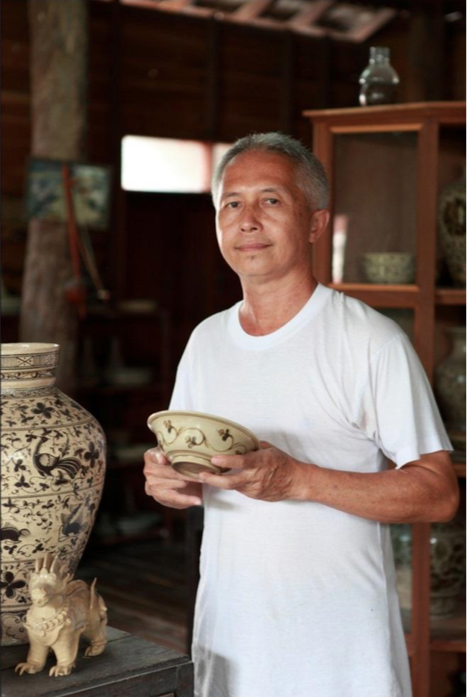
Tan Thichitang [cr. Chiang Rai Rajabhat University]
Today several groups of villagers are producing a modern-day version of the Wiang Kalong earthenware, of which 70% follows the same wisdom of ancient shapes and forms, while the remaining 30% covers modern dishware, glassware, teapots, and other decorative items.
In 2008, villagers in Wiang Kalong Sub-District formed a group to conserve the Mae Hua tributary. One of the group’s missions was to survey the site and other evidence to raise awareness in conservation and further nurture the site as a historical, cultural, and archaeological location.
The Wiang Kalong earthenware is now touted as the most important example of Lanna’s historical ceramic traditions. The unique potteries continue to flourish in the hands of those who live on the land. Students from Mae Jaedi Wittayakom School in Wieng Pa Pao district of Chiang Rai province are reproducing the patterns of their ancestors by drawing them on vases made of mango wood. Their craft is so successful that it has now become an enterprise named Ngam Wiang Kalong Co Ltd, which produces and sells products inspired by patterns from the Wiang Kalong lineage. A local museum has also been set up at Ban Thung Man in Wiang Kalong Sub-district to exhibit archaeological items found on the site.
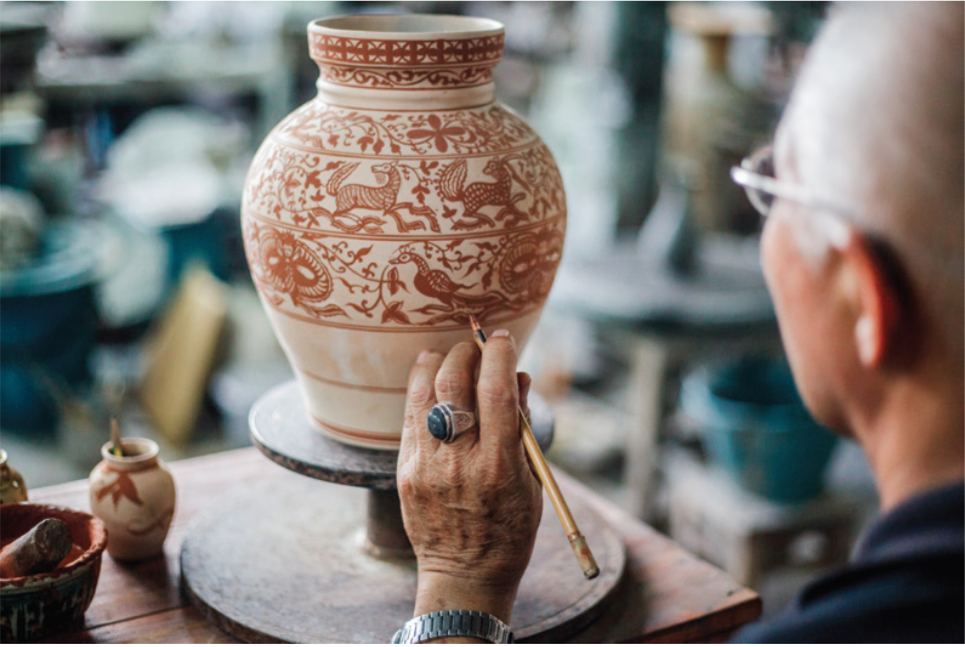
[cr. SACCICT]
**************************
Reference
Lerdkachatarn, Parisut. Krueng Pun Din Pao Jark Laeng Tao Wiang Kalong [Pottery from Wiang Kalong]. Watthanatham Journal: Department of Cultural Promotion, vol. 53, no. 3, July-September 2014, p. 24-33. Available at http://magazine.culture.go.th/2014/3/culturemag2014-3/assets/basic-html/index.html#24.


